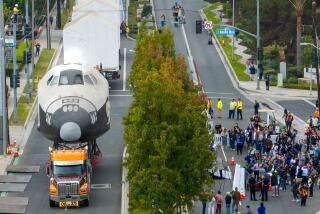Space shuttle Endeavour to make 12-mile trek on L.A. streets
In its 25 missions spanning nearly two decades, the space shuttle Endeavour circled the Earth more than 4,600 times, spending a total of 299 days in space.
It carried the crews that assembled the first U.S. component of the International Space Station, and would go on to dock at the station a dozen times. By the time Endeavour completed its last mission a year ago, the shuttle had logged nearly 123 million miles beyond Earth.
But the shuttle’s final journey — a measly 12 miles — might just be its most memorable.
Officials Wednesday unveiled some of the details surrounding the 170,000-pound shuttle’s carefully coordinated move from Florida’s Kennedy Space Center to its permanent home at the California Science Center in Exposition Park. After arriving at LAX on the back of a Boeing 747, the shuttle will make a two-day trek through the streets of Los Angeles, the first time a space shuttle has been moved through the heart of a city.
“In six weeks, Endeavour is coming back home to California,” California Science Center president Jeffrey Rudolph said at a news conference Wednesday. “This will mark the first, last and only time a space shuttle will travel through 12 miles of urban public streets. It’s not only one of the biggest objects transported down city streets, it’s an irreplaceable national treasure.”
Weather permitting, Endeavour will arrive at LAX Sept. 20, Rudolph said. There, a team of NASA engineers will lift the shuttle off the plane using cranes and a giant sling, and move it to a United Airlines hangar, where final preparations will be made for its ground transport.
The big move will continue Oct. 12 when the shuttle — nestled on the back of computer-controlled modular transporters — will begin its crawl along a route that includes Manchester Avenue and Crenshaw and Martin Luther King Jr.boulevards. The next day, the shuttle will stop at Inglewood City Hall and again at the intersection of Crenshaw and MLK, where a performance produced by actress and choreographer Debbie Allen will take place.
But moving the shuttle — which measures 57 feet tall at the tip of the tail and has a wingspan of 78 feet — will be no easy task, Rudolph said. Trees will be pruned back or taken out. Power lines will be raised. Traffic signals will be removed.
At its top speed, the transporters carrying the shuttle will travel about 2 mph along the city streets. At some points along the route, Endeavour will have less than a foot of clearance on either side and will creep even slower, Rudolph said.
For Angelenos, the move recalls the 105-mile journey a 340-ton granite boulder made from a remote Riverside quarry to the Los Angeles County Museum of Art in March. The 11-day move drew hundreds of onlookers and international media attention.
Endeavour’s move, Rudolph said, will be a far greater spectacle.
“That was a rock,” he said.
“This is an amazing thing with an amazing history — and it’s a lot bigger.”
NASA awarded Endeavour to the California Science Center last year after a fierce competition between museums nationwide. It was one of three retired orbiters that will go on permanent display; the others — Atlantis in Florida and Discovery at the Smithsonian outsideWashington, D.C. — have already reached their final destinations. A shuttle prototype, the Enterprise, is on display in New York.
The state-run California Science Center will house the shuttle in a temporary exhibit — open to the public Oct. 30 — until construction of a new air and space addition is complete.
Costs for the move and construction of the temporary and new exhibits will total about $200 million, Rudolph said. The money will come entirely from donations.
Los Angeles Mayor Antonio Villaraigosa, who also spoke at Wednesday’s news conference, said he anticipates people coming from across California and the U.S. to witness the shuttle’s move.
“Building the Endeavour was a marvel of ingenuity and engineering,” he said. “And moving the Endeavour will also be a marvel of ingenuity and engineering.”
Inglewood Mayor James T. Butts Jr. said Endeavour’s arrival in Los Angeles would mark a “great historic event for our children.”
“Space exploration represents that space between the confines of earth and God in his heaven,” he said. “It represents the opportunity to gain answers and insight beyond this pale existence we have.... I really am thankful, and our city is thankful, to be part of this piece of history.”
More to Read
Sign up for The Wild
We’ll help you find the best places to hike, bike and run, as well as the perfect silent spots for meditation and yoga.
You may occasionally receive promotional content from the Los Angeles Times.







